Dietary Exposure to Heavy Metal Contaminated Rice and Health Risk to the Population of Monrovia
Article Information
Lenn G Gomah1,3*, Rafael S Ngumbu2, Ray B Voegborlo3
1Department of Research and Interdisciplinary Studies, Honors College of Research and Interdisciplinary Studies, University of Liberia, Monrovia, Liberia
2Department of Chemistry, T.J.R Faulkner College of Science, University of Liberia, Monrovia, Liberia
3Department of Chemistry, College of Science, Kwame Nkrumah University of Science and Technology, Kumasi, Ghana
*Corresponding Author: Lenn G Gomah, Department of Research and Interdisciplinary Studies, Honors College of Research and Interdisciplinary Studies, University of Liberia, Monrovia, Liberia
Received: 02 August 2019; Accepted: 28 August 2019; Published: 30 September 2019
Citation: Lenn G Gomah, Rafael S Ngumbu, Ray B Voegborlo. Dietary Exposure to Heavy Metal Contaminated Rice and Health Risk to the Population of Monrovia. Journal of Environmental Science and Public Health 3 (2019): 474-482.
Share at FacebookAbstract
The aim of this study was to assess the exposure of the population of Monrovia to Heavy metals (Arsenic, Cadmium, Chromium, Lead, Mercury and Nickel) through the consumption of rice and the health risk posed. A total of forty one (41) imported and nineteen (19) locally cultivated rice samples were collected from major markets in Monrovia. A mixture of nitric, per chloric and sulfuric acids were used for complete digestion of the samples and the levels of the metals were determined using ICP-MS and AAS techniques. Dietary exposure of the consumers to the metals was assessed by comparing the Estimated Daily Intake (EDI) to the Provisional Tolerable Daily Intake (PTDI) of the metals, and the potential non-carcinogenic health risk was assessed using Hazard Quotients and Hazard Indices. Carcinogenic health risk from Arsenic was assessed by using Incremental Lifetime Cancer Risk values. Incremental Lifetime Cancer Risk values were less than the US EPA threshold value of 1.00E-04. Hazard Quotients and Hazard Indices for all the metals were less than US EPA permissible value of 1; suggesting that the consumption of the products constitute no potential individual or combined health risk to the population with regards to the tested metals. Although the current levels of heavy metals in the products are negligible, regular monitoring of contaminant levels is highly recommended.
Keywords
Rice, Heavy Metals, Health Risk Assessment, Hazard Indices, Monrovia, Liberia
Rice articles, Heavy Metals articles, Health Risk Assessment articles, Hazard Indices articles, Monrovia articles, Liberia articles
Rice articles Rice Research articles Rice review articles Rice PubMed articles Rice PubMed Central articles Rice 2023 articles Rice 2024 articles Rice Scopus articles Rice impact factor journals Rice Scopus journals Rice PubMed journals Rice medical journals Rice free journals Rice best journals Rice top journals Rice free medical journals Rice famous journals Rice Google Scholar indexed journals Heavy Metals articles Heavy Metals Research articles Heavy Metals review articles Heavy Metals PubMed articles Heavy Metals PubMed Central articles Heavy Metals 2023 articles Heavy Metals 2024 articles Heavy Metals Scopus articles Heavy Metals impact factor journals Heavy Metals Scopus journals Heavy Metals PubMed journals Heavy Metals medical journals Heavy Metals free journals Heavy Metals best journals Heavy Metals top journals Heavy Metals free medical journals Heavy Metals famous journals Heavy Metals Google Scholar indexed journals Health Risk Assessment articles Health Risk Assessment Research articles Health Risk Assessment review articles Health Risk Assessment PubMed articles Health Risk Assessment PubMed Central articles Health Risk Assessment 2023 articles Health Risk Assessment 2024 articles Health Risk Assessment Scopus articles Health Risk Assessment impact factor journals Health Risk Assessment Scopus journals Health Risk Assessment PubMed journals Health Risk Assessment medical journals Health Risk Assessment free journals Health Risk Assessment best journals Health Risk Assessment top journals Health Risk Assessment free medical journals Health Risk Assessment famous journals Health Risk Assessment Google Scholar indexed journals Hazard Indices articles Hazard Indices Research articles Hazard Indices review articles Hazard Indices PubMed articles Hazard Indices PubMed Central articles Hazard Indices 2023 articles Hazard Indices 2024 articles Hazard Indices Scopus articles Hazard Indices impact factor journals Hazard Indices Scopus journals Hazard Indices PubMed journals Hazard Indices medical journals Hazard Indices free journals Hazard Indices best journals Hazard Indices top journals Hazard Indices free medical journals Hazard Indices famous journals Hazard Indices Google Scholar indexed journals Wastewater articles Wastewater Research articles Wastewater review articles Wastewater PubMed articles Wastewater PubMed Central articles Wastewater 2023 articles Wastewater 2024 articles Wastewater Scopus articles Wastewater impact factor journals Wastewater Scopus journals Wastewater PubMed journals Wastewater medical journals Wastewater free journals Wastewater best journals Wastewater top journals Wastewater free medical journals Wastewater famous journals Wastewater Google Scholar indexed journals agricultural soil articles agricultural soil Research articles agricultural soil review articles agricultural soil PubMed articles agricultural soil PubMed Central articles agricultural soil 2023 articles agricultural soil 2024 articles agricultural soil Scopus articles agricultural soil impact factor journals agricultural soil Scopus journals agricultural soil PubMed journals agricultural soil medical journals agricultural soil free journals agricultural soil best journals agricultural soil top journals agricultural soil free medical journals agricultural soil famous journals agricultural soil Google Scholar indexed journals Mercury articles Mercury Research articles Mercury review articles Mercury PubMed articles Mercury PubMed Central articles Mercury 2023 articles Mercury 2024 articles Mercury Scopus articles Mercury impact factor journals Mercury Scopus journals Mercury PubMed journals Mercury medical journals Mercury free journals Mercury best journals Mercury top journals Mercury free medical journals Mercury famous journals Mercury Google Scholar indexed journals glassware articles glassware Research articles glassware review articles glassware PubMed articles glassware PubMed Central articles glassware 2023 articles glassware 2024 articles glassware Scopus articles glassware impact factor journals glassware Scopus journals glassware PubMed journals glassware medical journals glassware free journals glassware best journals glassware top journals glassware free medical journals glassware famous journals glassware Google Scholar indexed journals health effects articles health effects Research articles health effects review articles health effects PubMed articles health effects PubMed Central articles health effects 2023 articles health effects 2024 articles health effects Scopus articles health effects impact factor journals health effects Scopus journals health effects PubMed journals health effects medical journals health effects free journals health effects best journals health effects top journals health effects free medical journals health effects famous journals health effects Google Scholar indexed journals
Article Details
1. Introduction
Rice is the second most cultivated cereal and the third most worldwide produced crop behind wheat and maize. It is the staple food for most of the world’s populace and the leading dietary energy provider [1]. In Monrovia, it is the widely consumed crop. In recent years, there have been growing concerns over the contamination of the crop by heavy metals. Many industrial processes and other anthropogenic activities can lead to contamination of agricultural soil with heavy metal. Metals in soil can enter the food chain by bio accumulating in edible vegetables and crops [2]. High dietary exposure to heavy metals from rice has been reported in literature [3-6]. Like in plants, heavy metals such as As, Cd, Cr, Pb, Hg and Ni can accumulate in human tissues and organs such as livers, bones, and muscles; and pose serious health effects [7]. Arsenic is very carcinogenic and causes arsenicosis, forms complexes and hinders the production of Adenosine Triphosphates during respiration. Cadmium affects the bone and caused kidney and renal disorder in human. Mercury is known to cause gastrointestinal disorder, acrodynia diseases, brain and central nervous system damages. Nickel induces mutagenesis, inhibits DNA excision repairs, causes chromosome damage and several allergic reactions. Chromium is noted to cause skin cancer, lungs ailment and liver damages; whereas Lead has the ability to cause anemia, weakness in muscles, lethargy and paralysis [8, 9].
One of the major ways the general population can be exposed to heavy metals is through the consumption of contaminated crops and vegetables as food [10]. This path of exposure has intensified the need for quality and safety monitoring of food. This is done in order to protect human against the adverse health effects of these metals through dietary consumption. Prior to this study, no previous study had ascertained the health risk posed to the population of Monrovia from the consumption of heavy metal contaminated rice. The different types of rice consumed by the inhabitants of Monrovia may have contained heavy metals above recommended levels that would have caused serious health effects to the population. Therefore, this study was relevant as it provides a useful reference data for future research as it relates to the dietary exposure and health risk from heavy metal to the population through the consumption of the nation’s staple food, rice.
2. Methodology
2.1 Sampling
A total of forty-one imported and nineteen locally cultivated rice samples comprising of twenty and nine brands respectively, were randomly purchased from six major markets in Monrovia, Liberia. Samples were collected based on production dates and batches within each brand and were representative of all commercially available rice brands on the Liberian markets during the sampling period. Brands collected are widely consumed in the city. Table-1 lists the rice brands sampled in this study.
Table 1: List of rice brands sampled in this study.
|
Americanna |
Firestone Parboil |
Lady Norah |
Pure White * |
Six Months * |
|
Bellaluna 1 |
Horse |
Lion |
Red Rice* |
UCI |
|
Bellaluna 2 |
Indo-Lion |
Lofa Rice* |
Red Star |
Uncle Mario |
|
Bitter International |
IR-64 |
Nimba Rice* |
Royal Elephant |
Uncle Sam |
|
Bong Rice* |
Kissi Rice* |
Nobel Express |
Royal Parboil |
USA Parboil |
|
Crown |
Kpelleh Rice* |
Old Lady* |
Savanna |
- |
*Local Rice
2.2 Sample preparation and digestion
Samples were washed, air dried, pulverized and then digested using a mixture of nitric, per chloric and sulfuric acids in an open flask digestion procedure [11]. In the procedure, 1 g of pulverized sample each was weighed into a 50 mL graduated digestion flask, and 1 mL H2O, 4 mL (1:1) HNO3 -HClO4 and 5 mL H2SO4 were added in turns to the sample in the flask. The flask with contents were then inserted into an aluminum heating block and placed on an electric hotplate set at 200°C until clear transparent solutions were obtained. They were then removed from the hot plate, allowed to cool and diluted to the 50 mL mark with deionized water. Digestion blanks were prepared during the digestion procedures. All reagents were of analytical grade (Merck, Darmstadt, Germany) and all glassware, digestion flasks and polyethylene bottles used for digestion and storage of samples were pre-washed, soaked in detergent water for two hours, washed properly and rinsed with deionized water and then soaked in 10% (v/v) HNO3 for about 20 hours. Thereafter, they were rinsed with deionized water followed by 0.5% (w/v) KMnO4 solution and finally rinsed with deionized water and then allowed to air dry before use.
2.3 Determination of the metals
Agilent 7900 (Agilent Technology, USA) Inductively Coupled Plasma Mass Spectrophotometer was used to determine the levels of As, Cd, Cr, Pb and Ni in the digested samples by the ICP-MS technique, and Lumex RA-915M Automatic Mercury Analyzer (Lumex Instruments, Canada) was employed for the determination of Hg in the digests by Atomic Absorption Spectroscopy technique. Prior to that, calibration standard with varying concentrations were prepared from the stock solutions of the analytes and the instruments were used to establish calibration curves, from which the concentration of the analytes in the digests were determined.
2.4 Quality assurance
Recovery analysis was performed to confirm the accuracy of the analytical methods employed in this study. This was done by spiking one sample with known amount of the standard solutions of the metals. The spiked samples were then treated and analyzed under the same conditions as the other samples to determine the percent recoveries.
2.5 Statistical analysis
Microsoft Excel (v2016) tools were employed for statistical analysis.
2.6 Dietary exposure
Dietary Exposure of the population to the metals was assessed by computing estimates of daily metal intake through the consumption of the rice samples. Dietary exposure in the form of Estimated Daily Intake (EDI), was computed by using equation 1.
EDI (mg/kg/day) = (Cm × DCR)/Bw (1)
Where “Cm” is the Measured Concentration of the metal in rice samples
“DCR” is the rice Daily Consumption Rate of the population of Monrovia.
“Bw” is the average Body Weight of adult.
2.7 Health risk assessment
Health risk effects posed to the population of Monrovia from the consumption of contaminated rice with heavy metals was conducted according to the US EPA integrated metal risk assessment guideline [12]. The non-carcinogenic health risk was assessed by using Hazard Quotients (HQ) and Hazard Indices (HI). Carcinogenic health risk was assessed by using Incremental Lifetime Cancer Risk (ILCR) value of the carcinogenic metal. HQ, HI and ILCR were calculated using Equation 2, 3 and 4 respectively.
HQ = EDI/RfD (2)
HI = HQ1 + HQ2 + …. HQn (3)
ILCR = CDI × CSF (4)
Where “RfD” is the reference doses of the metals; “CDI “is the Chronic Daily intake of the metals; “CSF” is the ingestion Cancer Slope Factor of the metals, The reference doses and cancer slope factors of the tested metals are given in Table 2. Chronic Daily Intake was calculated from the following equation.
CDI (mg/kg/day) = (EDI × EFr × EDtot)/AT (5)
Where “EFr” is the Frequency of Exposure; “EDtot” is the Total Duration of Exposure; “AT” is the Period of Exposure.
Table 2: Reference Doses and Slope Cancer Factors of the metals.
|
Parameter |
As |
Cd |
Cr |
Hg |
Ni |
Pb |
References |
|
RfD (mg/kg/day) |
0.0003 |
0.001 |
0.003 |
0.0036 |
0.0001 |
0.02 |
[13, 14] |
|
CSF (mg/kg/day)-1 |
1.5 |
N/A |
N/A |
N/A |
N/A |
N/A |
N/A = Not available
Table 3: Constant Parameters considered in the determination of health risk.
|
Parameter |
Value |
References |
|
DCR (g/day) |
248 |
[12, 15, 16] |
|
BW (kg) |
70 |
|
|
EFr (days) |
365 |
|
|
AT (years) |
70 |
|
|
EDtot (years) |
61.5 |
3. Result and Discussion
The study analyzed the levels of As, Cd, Cr, Hg, Pb and Ni in a total of sixry (60) rice samples consumed in Monrovia. Ten replicates of two randomly selected samples each were treated and analyzed under similar conditions to assess the degree of precision or repeatability of the results obtained. The Relative Standard Deviations from the data sets ranged from 8.887% to 12.121%. The accuracy of the analytical methods was assessed by spiking one sample with known amount of the standard solutions of the metals. The percent recoveries ranged from 87% to 105% (Table 4). The levels of metals in the tested rice samples are presented in Figure 1. Though the selected metals were all present in the selected rice samples, they were all below the respective standards set by the Codex Alimentary Commission, the European Commission and the People’s Republic of China [17-19]. This indicate low contamination of the products by heavy metals. Overall, Red Star, Uncle Sam, Kissi Rice, Belleluna 1, Kpelleh Rice and Lady Norah recorded the highest concentration of As (0.0181 mg/kg), Cd (0.1179 mg/kg), Cr (0.4245 mg/kg), Pb (0.0371 mg/kg), Hg (0.0094 mg/kg) and Ni (0.6552 mg/kg) respectively. Soil pH and redox potential are the major factors that account for the presence of heavy metals in rice grains. However, the application of silicon fertilizer, which is usually practiced in rice production, enhanced their toxicities in the plant. The concentration levels of the selected metals recorded in this study were similar to or lower than the ones recorded in studies conducted in China, India, Bangladesh, Pakistan, Brazil, Spain and the USA [20-25].
Dietary exposure of the consumers to the metals were very low, as indicated from the Estimated Daily intake values obtained. Estimated Daily Intake values of the metals were all significantly below their respective Provisional Tolerable Daily Intake values recommended by the Joint FAO/WHO Expert Committee on Food Additives (Figure 2). This showed that at the current rice consumption rate, the amount of the metals ingested is insignificant. In order to exceed the recommended daily threshold limit, an average person must consume higher amount of the products per day. For example, the highest concentration of As (0.0181 mg/kg) in the tested samples was found in Red Star. If an inhabitant of Monrovia consumed 248 g of Red Star per day, he/she consumed approximately 0.000064 mg of As per day, which is far below the 0.00214 mg limit set by JECFA. To exceed the limit, one will have to consume over 8.27 Kg of Red Star per day. This is highly unlikely.
Hazard quotients recorded for the metals ranged from 0.001 to 0.501 (Figure 3). The values were below the US EPA permissible limit of 1; implying no potential non-carcinogenic health risks from each of the metals to the population. The low level of risk might be due to the low exposure rate of the population to the metals. The cumulative intake of the metals in the form of Hazard indices were also below the US EPA permissible limit; further suggesting no non carcinogenic potential health risk to the population from the combination of the metals (Figure 4). The values obtained for the Incremental Lifetime Cancer Risks for As through the consumption of rice samples analyzed in this study ranged from 6.0 × 10-6 to 8.4 × 10-5. According to the US EPA, any Incremental Lifetime Cancer Risk value equal to or less than 10-4 is labelled safe and pose no considerable expected carcinogenic health risk to a population [26]. The highest Chronic Daily Intake value for As (0.000056 mg/kg/day) in the tested rice samples was found in Red Star. However, as revealed from the obtained Incremental Lifetime Cancer Risk value (8.4 × 10-5), it is significantly low to produce chronic effect from long term consumption of the product at the current level of contamination and consumption rate (Figure 5).
Table 4: Percent Recovery of Spiked Rice Sample.
|
Element |
As |
Cd |
Cr |
Pb |
Hg |
Ni |
|
Amount Added (µg/g) |
0.0250 |
0.0250 |
0.0250 |
0.0250 |
0.0250 |
0.0250 |
|
Amount Recovered (µg/g) |
0.0262 |
0.0236 |
0.0217 |
0.0217 |
0.0254 |
0.0257 |
|
Percent Recovery (%) |
105 |
94 |
87 |
87 |
102 |
103 |
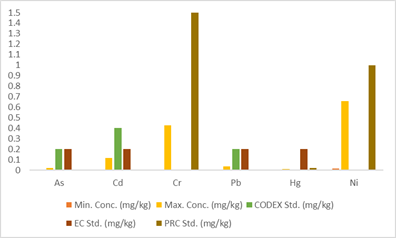
Figure 1: Concentrations (mg/kg) of metals in the tested rice samples.
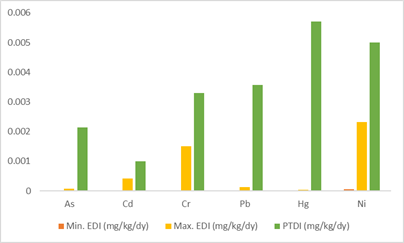
Figure 2: Estimated Daily Intake (mg/kg/day) of metals in the tested rice samples.
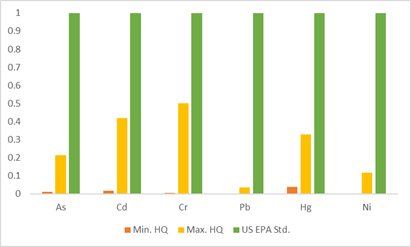
Figure 3: Hazard Quotients of metals in the tested rice samples.
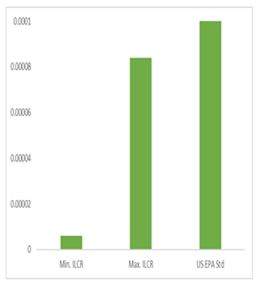
Figure 4: ILCR range of As.
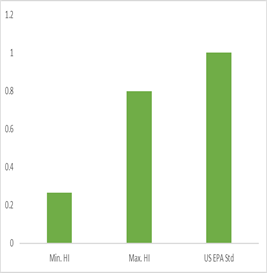
Figure 5: Hazard Indices range of the metals.
4. Conclusion
The study assessed the risk associated with the consumption of metal contaminated rice sold on the markets in Monrovia. Though the rice samples recorded traces of tthe selected metals, the level of contamination is low to produce any significant health effect to the population. The observed dietary intake values of each of the metals were less than JECFA permissible safety limits, and the Hazard Quotients and Hazard Indices were also less than the US EPA permissible safety limit, confirming that the population is not at any significant health risk to As, Cd, Cr, Pb, Hg and Ni exposure through the consumption of the selected rice brands. However, there is a possibility of health effect to the population if there is a considerable increase in the levels of the metals in the products. The authors, therefore, recommend regular monitoring of heavy metal levels in rice brands and other food products sold on the markets in Monrovia.
Conflict of Interest
The authors declared no conflict of interest with respect to the research, authorship and/or publication of this article.
References
- Calpe C. Rice international commodity profile. Market and Trade Division of the Food Agricuture Organization. Rome (2006): 7-23.
- Zarcinas BA, Pongsakul P, McLaughlin, et al. Heavy metals in soils and crops in Southeast Asia. Environ Geochem Health 26 (2004): 359-371.
- Fu J, Zhou Q, Liu J, et al. High levels of heavy metals in rice ( Oryza sativa L .) from a typical E-waste recycling area in southeast China and its potential risk to human health. Chemosphere 71 (2008): 1269-1275.
- Cao H, Chen J, Zhang H, et al. Heavy metals in rice and garden vegetables and their potential health risks to inhabitants in the vicinity of an industrial zone in Jiangsu, China. J Environ Sci 22 (2010): 1792-1799.
- Al-Saleh I and Shinwari N. Levels of Cadmium, Lead, and Mercury in Human Brain Tumors. Biol Trace Elem Res 83 (2001): 197-203.
- Fan Y, Zhu T, Li M, et al. Heavy Metal Contamination in Soil and Brown Rice and Human Health Risk Assessment near Three Mining Areas in Central China. J Healthc Eng 1 (2017): 81-90.
- Chary SN, Kamala CT and Raj DSS. Assessing risk of heavy metals from consuming food grown on sewage irrigated soils and food chain transfer. Ecotoxicol Environ Saf 69 (2008): 513-524.
- Sharma RK and Agrawal M. Biological effects of heavy metals: An overview. J Environ Biol 26 (2014): 301-313.
- Barakat MA. New trends in removing heavy metals from industrial wastewater. Arab J Chem 4 (2011): 361-377.
- Järup L. Hazards of heavy metal contamination. Br Med Bull 68 (2003): 167-182.
- Voegborlo RB, Akagi H. Determination of mercury in fish by cold vapour atomic absorption spectrometry using an automatic mercury analyzer. Food Chem 100 (2007): 853-858.
- United States Environmental Protection Agency. United States Environmental Protection Agency Framework for Metals Risk Assessment (2014).
- United States Environmental Protection Agency. United States Environmental Protection Agency Integrated Risk Information System (IRIS).
- World Health Organization. Adverse Health Effect of Heavy Metals in Children (2011).
- Global Alliance for Improved Nutrition. Food Fortification Initiative: Enhancing Grains for Healthier Lives (Republic of Liberia); Geneva (2016): 6-10.
- World Health Organization. WHO Global Health Observatory, Liberia.
- European Commission. Commission Regulation (EC) No 1881/2006 of 19 December 2006 setting: maximum levels for certain contaminants in foodstuffs. Off J Eur Communitites 364 (2006): 5-24.
- CODEX Alimentarius Commission. Codex General Standard for Contaminants and Toxins in Food and Feed (Codex Stan 193-1995).
- Bugang W and Woolsey M. National Food Safety Standard-Maximum Levels of Contaminants in Foods (GB 2762-2010). Global Agricultural Information Network, USDA. Washington D.C (2010): 2-7.
- Jolly YN, Huque R and Islam A. Toxic Elements in Rice and Possible Health Risk Assessment – Bangladesh Prospect. J Food Process 4 (2014): 101-109.
- Ferré-Huguet N, Martí-Cid R, Schuhmacher M, et al. Risk assessment of metals from consuming vegetables, fruits and rice grown on soils irrigated with waters of the Ebro River in Catalonia, Spain. Biol Trace Elem Res 123 (2008): 66-79.
- Giri S and Singh AK. Human health risk assessment due to dietary intake of heavy metals through rice in the mining areas of Singhbhum Copper Belt, India. Environ Sci Pollut Res 24 (2017): 149-161.
- Song D, Zhuang D, Jiang D, et al. Integrated health risk assessment of heavy metals in Suxian county, South China. Int J Environ Res Public Health 12 (2015): 7100-7117.
- Zavala YJ and Duxbury JM. Arsenic in Rice: Estimating Normal Levels of Total Arsenic in Rice Grain. Environ Sci Technol 42 (2008): 3856-3860.
- Da Silva MJ, Paim APS, Pimentel MF, et al. Determination of mercury in rice by cold vapor atomic fluorescence spectrometry after microwave-assisted digestion. Anal Chim Acta 667 (2008): 43-48.
- United States Environmental Protection Agency. EPA’s Integrated Risk Information System: Updates on Process Changes and Assessments.
